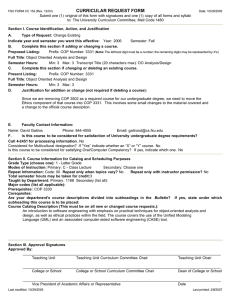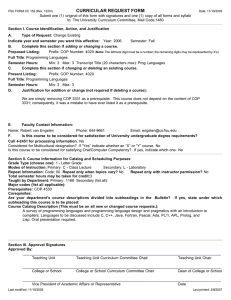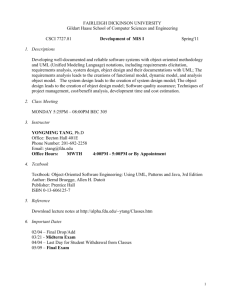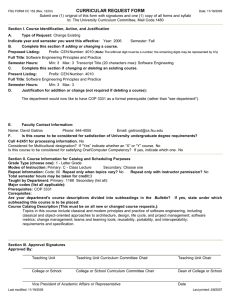Modeling and UML UML = Unified Modeling Language Graphical Notation Topics
advertisement
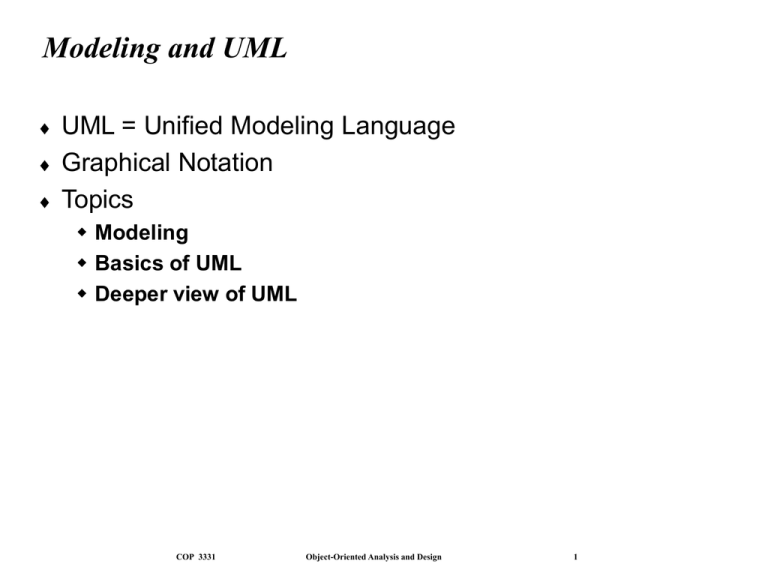
Modeling and UML
UML = Unified Modeling Language
Graphical Notation
Topics
Modeling
Basics of UML
Deeper view of UML
COP 3331
Object-Oriented Analysis and Design
1
What is modeling?
Modeling consists of building an abstraction of reality.
Abstractions are simplifications because:
They ignore irrelevant details and
They only represent the relevant details.
What is relevant or irrelevant depends on the purpose of
the model.
COP 3331
Object-Oriented Analysis and Design
2
Why model software?
Why model software?
Software is getting increasingly more complex
Windows XP > 40 million lines of code
A single programmer cannot manage this amount of code in
its entirety.
Code is not easily understandable by developers who did
not write it
We need simpler representations for complex systems
Modeling is a mean for dealing with complexity
COP 3331
Object-Oriented Analysis and Design
3
Systems, Models and Views
A model is an abstraction describing a subset of a system
A view depicts selected aspects of a model
A notation is a set of graphical or textual rules for depicting
views
Views and models of a single system may overlap each
other
Examples:
System: Aircraft
Models: Flight simulator, scale model
Views: All blueprints, electrical wiring, fuel system
COP 3331
Object-Oriented Analysis and Design
4
Systems, Models and Views
Flightsimulator
Blueprints
Aircraft
Model 2
System
View 1
View 2
View 3
Model 1
Scale Model
COP 3331
Object-Oriented Analysis and Design
Electrical
Wiring
5
Models, Views and Systems (UML)
*
System
*
Model
View
Depicted by
Described by
Airplane: System
Scale Model: Model
Blueprints: View
COP 3331
Flight Simulator: Model
Fuel System: View
Object-Oriented Analysis and Design
Electrical Wiring: View
6
Concepts and Phenomena
Phenomenon
An object in the world of a domain as you perceive it
Example: The lecture you are attending
Example: Clock
Concept
Describes the properties of phenomena that are common.
Example: Lectures on software engineering
Example: Clocks
Concept is a 3-tuple:
Name (To distinguish it from other concepts)
Purpose (Properties that determine if a phenomenon is a
member of a concept)
Members (The set of phenomena which are part of the
concept)
COP 3331
Object-Oriented Analysis and Design
7
Concepts and phenomena
Name
Purpose
Clock
Members
A device that
measures time.
Abstraction
Classification of phenomena into concepts
Modeling
Development of abstractions to answer specific questions about a
set of phenomena while ignoring irrelevant details.
COP 3331
Object-Oriented Analysis and Design
8
Concepts in software: Type and Instance
Type:
An abstraction in the context of programming languages
Name: int, Purpose: integral number, Members: 0, 1, -1,
2, -2, . . .
Instance:
Member of a specific type
The type of a variable represents all possible instances
the variable can take
The following relationships are similar:
“type” <–> “instance”
“concept” <–> “phenomenon”
COP 3331
Object-Oriented Analysis and Design
9
Abstract Data Types & Classes
Abstract data type
Special type whose implementation is
hidden from the rest of the system.
Class:
An abstraction in the context of objectoriented languages
time
date
SetDate(d)
Like an abstract data type, a class
encapsulates both state (variables)
and behavior (methods)
CalculatorWatch
Class Vector
Watch
Unlike abstract data types, classes can calculatorState
be defined in terms of other classes
EnterCalcMode()
using inheritance
InputNumber(n)
COP 3331
Object-Oriented Analysis and Design
10
Application and Solution Domain
Application Domain (Requirements Analysis):
The environment in which the system is operating
Solution Domain (System Design, Object Design):
The available technologies to build the system
COP 3331
Object-Oriented Analysis and Design
11
Object-oriented modeling
Application Domain
Application Domain Model
UML Package
TrafficControl
Aircraft
SummaryDisplay
TrafficController
FlightPlan
COP 3331
Solution Domain
System Model
Airport
Object-Oriented Analysis and Design
MapDisplay
FlightPlanDatabase
TrafficControl
12
What is UML?
UML (Unified Modeling Language)
An emerging standard for modeling object-oriented software.
Resulted from the convergence of notations from three
leading object-oriented methods:
OMT (James Rumbaugh)
OOSE (Ivar Jacobson)
Booch (Grady Booch)
Reference: “The Unified Modeling Language User
Guide”, Addison Wesley, 1999.
Supported by several CASE tools
Rational ROSE
TogetherJ
COP 3331
Object-Oriented Analysis and Design
13
UML: First Pass
You can model 80% of most problems by using about 20
% UML
This 20% discussed here
COP 3331
Object-Oriented Analysis and Design
14
UML First Pass
Use case Diagrams
Describe the functional behavior of the system as seen by the user.
Class diagrams
Describe the static structure of the system: Objects, Attributes,
Associations
Sequence diagrams
Describe the dynamic behavior between actors and the system and
between objects of the system
Statechart diagrams
Describe the dynamic behavior of an individual object (essentially a
finite state automaton)
Activity Diagrams
Model the dynamic behavior of a system, in particular the workflow
(essentially a flowchart)
COP 3331
Object-Oriented Analysis and Design
15
UML first pass: Use case diagrams
Use case
Package
Watch
Actor
ReadTime
SetTime
WatchUser
WatchRepairPerson
ChangeBattery
Use case diagrams represent the functionality of the system
from user’s point of view
COP 3331
Object-Oriented Analysis and Design
16
UML first pass: Class diagrams
Class diagrams represent the structure of the system
Association
Class
Multiplicity
Watch
1
2
PushButton
state
push()
release()
Attribute
1
1
1
2
1
LCDDisplay
blinkIdx
blinkSeconds()
blinkMinutes()
blinkHours()
stopBlinking()
referesh()
1
Battery
load
Time
now
Operations
COP 3331
Object-Oriented Analysis and Design
17
UML first pass: Sequence diagram
Actor
:Watch
:WatchUser
Message
Object
:LCDDisplay
pressButton1()
blinkHours()
pressButton1()
blinkMinutes()
pressButton2()
:Time
incrementMinutes()
refresh()
pressButtons1And2()
commitNewTime()
stopBlinking()
Activation
Lifeline
Sequence diagrams represent the behavior as interactions
COP 3331
Object-Oriented Analysis and Design
18
UML first pass: Statechart diagrams for objects
with interesting dynamic behavior
State
Event
Initial state
[button1&2Pressed]
BlinkHours
Transition
[button2Pressed]
IncrementHrs
[button1Pressed]
[button1&2Pressed]
BlinkMinutes
[button2Pressed]
IncrementMin.
[button1Pressed]
[button1&2Pressed]
BlinkSeconds
StopBlinking
[button2Pressed]
IncrementSec.
Final state
Represent behavior as states and transitions
COP 3331
Object-Oriented Analysis and Design
19
Other UML Notations
Other UML concepts and notations will be introduced later,
as needed.
Implementation diagrams (System Design)
Component diagrams
Deployment diagrams
Object constraint language (Object Design)
COP 3331
Object-Oriented Analysis and Design
20
UML Core Conventions
Rectangles are classes or instances (objects)
Ovals are functions or use cases
Instances are denoted with an underlined names
myWatch:SimpleWatch
Joe:Firefighter
Types are denoted with non underlined names
SimpleWatch
Firefighter
Diagrams are graphs
Nodes are entities
Arcs are relationships between entities
COP 3331
Object-Oriented Analysis and Design
21
Use Case Diagrams
Used during requirements
elicitation to represent external
behavior
Actors represent roles, that is,
a type of user of the system
Passenger
Use cases represent a
sequence of interaction for a
type of functionality
The use case model is the set
of all use cases. It is a
complete description of the
of the system and
PurchaseTicket functionality
its environment
COP 3331
Object-Oriented Analysis and Design
22
Actors
An actor models an external entity which
communicates with the system:
User
External system
Physical environment
Passenger
An actor has a unique name and an
optional description.
Examples:
Passenger: A person in the train
GPS satellite: Provides the system with
GPS coordinates
COP 3331
Object-Oriented Analysis and Design
23
Use Case
A use case represents a functionality
provided by the system as an event
flow.
A use case consists of:
PurchaseTicket Unique name
Participating actors
Entry conditions
Flow of events
Exit conditions
Special requirements
COP 3331
Object-Oriented Analysis and Design
24
Use Case Diagram: Example
Name: Purchase ticket
Participating actor: Passenger
Entry condition:
Passenger standing in front of
ticket distributor.
Passenger has sufficient
money to purchase ticket.
Exit condition:
Passenger has ticket.
Event flow:
1. Passenger selects the number
of zones to be traveled.
2. Distributor displays the
amount due.
3. Passenger inserts money, of
at least the amount due.
4. Distributor returns change.
5. Distributor issues ticket.
Anything missing?
Exceptional cases!
COP 3331
Object-Oriented Analysis and Design
25
The <<extends>> Relationship
Passenger
PurchaseTicket
<<extends>>
<<extends>> relationships
represent exceptional or
seldom invoked cases.
The exceptional event flows are
factored out of the main event
flow for clarity.
Use cases representing
exceptional flows can extend
more than one use case.
The direction of a <<extends>>
relationship is to the extended
use case
<<extends>>
<<extends>>
OutOfOrder
<<extends>>
Cancel
COP 3331
TimeOut
NoChange
Object-Oriented Analysis and Design
26
The <<includes>> Relationship
Passenger
PurchaseMultiCard
PurchaseSingleTicket
<<includes>>
<<includes>>
<<extends>>
CollectMoney
NoChange
<<includes>> relationship
represents behavior that is
factored out of the use case.
<<includes>> behavior is
factored out for reuse, not
because it is an exception.
The direction of a
<<includes>> relationship is to
the using use case (unlike
<<extends>> relationships).
<<extends>>
Cancel
COP 3331
Object-Oriented Analysis and Design
27
Use Case Diagrams: Summary
Use case diagrams represent external behavior
Use case diagrams are useful as an index into the use
cases
Use case descriptions provide meat of model, not the use
case diagrams.
All use cases need to be described for the model to be
useful.
COP 3331
Object-Oriented Analysis and Design
28
Class Diagrams
TarifSchedule
Enumeration getZones()
Price getPrice(Zone)
*
*
Trip
zone:Zone
Price: Price
Class diagrams represent the structure of the system.
Used
during requirements analysis to model problem domain
concepts
during system design to model subsystems and interfaces
during object design to model classes.
COP 3331
Object-Oriented Analysis and Design
29
Classes
Name
TarifSchedule
zone2price
getZones()
getPrice()
Attributes
Operations
TarifSchedule
Table zone2price
Enumeration getZones()
Price getPrice(Zone)
Signature
TarifSchedule
A class represent a concept
A class encapsulates state (attributes) and behavior (operations).
Each attribute has a type.
Each operation has a signature.
The class name is the only mandatory information.
COP 3331
Object-Oriented Analysis and Design
30
Instances
tarif_1974:TarifSchedule
zone2price = {
{‘1’, .20},
{‘2’, .40},
{‘3’, .60}}
An instance represents a phenomenon.
The name of an instance is underlined and can contain the class of
the instance.
The attributes are represented with their values.
COP 3331
Object-Oriented Analysis and Design
31
Actor vs Instances
What is the difference between an actor , a class and an
instance?
Actor:
An entity outside the system to be modeled, interacting with
the system (“Passenger”)
Class:
An abstraction modeling an entity in the problem domain,
must be modeled inside the system (“User”)
Object:
A specific instance of a class (“Joe, the passenger who is
purchasing a ticket from the ticket distributor”).
COP 3331
Object-Oriented Analysis and Design
32
Associations
TarifSchedule
TripLeg
Enumeration getZones()
Price getPrice(Zone)
Price
Zone
*
*
Associations denote relationships between classes.
The multiplicity of an association end denotes how many objects the
source object can legitimately reference.
COP 3331
Object-Oriented Analysis and Design
33
1-to-1 and 1-to-many Associations *
Has-capital
Country
name:String
City
name:String
One-to-one association
Point
*
Polygon
x: Integer
y: Integer
draw()
One-to-many association
COP 3331
Object-Oriented Analysis and Design
34
Many-to-Many Associations
StockExchange
*
Lists
*
Company
tickerSymbol
StockExchange
COP 3331
*
Lists
tickerSymbol
Object-Oriented Analysis and Design
1
SX_ID
Company
35
From Problem Statement To Object Model
Problem Statement: A stock exchange lists many companies. Each
company is uniquely identified by a ticker symbol
Class Diagram:
StockExchange *
COP 3331
*
Lists
Object-Oriented Analysis and Design
Company
tickerSymbol
36
From Problem Statement to Code
Problem Statement : A stock exchange lists many companies.
Each company is identified by a ticker Symbol
Class Diagram:
StockExchange
*
Lists
*
Company
tickerSymbol
Java Code
public class StockExchange
{
private Vector m_Company = new Vector();
};
public class Company
{
public int m_tickerSymbol;
private Vector m_StockExchange = new Vector();
};
COP 3331
Object-Oriented Analysis and Design
37
Aggregation
An aggregation is a special case of association denoting a “consists of”
hierarchy.
The aggregate is the parent class, the components are the children
class.
Exhaust system
0..2
1
Muffler
Tailpipe
diameter
diameter
A solid diamond denotes composition, a strong form of aggregation
where components cannot exist without the aggregate. (Bill of Material)
TicketMachine
3
ZoneButton
COP 3331
Object-Oriented Analysis and Design
38
Qualifiers
Without qualification
Directory
1
File
*
filename
With qualification
Directory
filename
1
0…1
File
Qualifiers can be used to reduce the multiplicity of an
association.
COP 3331
Object-Oriented Analysis and Design
39
Inheritance
Button
CancelButton
ZoneButton
The children classes inherit the attributes and
operations of the parent class.
Inheritance simplifies the model by eliminating
redundancy.
COP 3331
Object-Oriented Analysis and Design
40
Object Modeling in Practice: Class Identification
Foo
Balance
CustomerId
Deposit()
Withdraw()
GetBalance()
Class Identification: Name of Class, Attributes and Methods
COP 3331
Object-Oriented Analysis and Design
41
Object Modeling in Practice:
Encourage Brainstorming
“Dada”
Foo
Balance
Balance
CustomerId
CustomerId
Deposit()
Withdraw()
GetBalance()
Deposit()
Withdraw()
GetBalance()
Account
Balance
CustomerId
Naming is important!
Is Foo the right name?
COP 3331
Object-Oriented Analysis and Design
Deposit()
Withdraw()
GetBalance()
42
Object Modeling in Practice ctd
Account
Balance
AccountId
CustomerId
Bank
Customer
Name
CustomerId
Deposit()
Withdraw()
GetBalance()
Name
1) Find New Objects
2) Iterate on Names, Attributes and Methods
COP 3331
Object-Oriented Analysis and Design
43
Object Modeling in Practice: A Banking System
Account
Balance
AccountId
CustomerId
AccountI
d
Deposit()
Withdraw()
GetBalance()
Bank
Name
*
Customer
Has
Name
CustomerId
1) Find New Objects
2) Iterate on Names, Attributes and Methods
3) Find Associations between Objects
4) Label the assocations
5) Determine the multiplicity of the assocations
COP 3331
Object-Oriented Analysis and Design
44
Practice Object Modeling: Iterate, Categorize!
Account
Bank
*
Name
Savings
Account
Withdraw()
COP 3331
Customer
Balance
AccountId
CustomerId
AccountI
d
Deposit()
Withdraw()
GetBalance()
Checking
Account
Withdraw()
Object-Oriented Analysis and Design
*
Has
Name
CustomerId()
Mortgage
Account
Withdraw()
45
Packages
A package is a UML mechanism for organizing elements
into groups (usually not an application domain concept)
Packages are the basic grouping construct with which
you may organize UML models to increase their
readability.
DispatcherInterface
Notification
IncidentManagement
A complex system can be decomposed into subsystems,
where each subsystem is modeled as a package
COP 3331
Object-Oriented Analysis and Design
46
UML sequence diagrams
TicketMachine
Passenger
To refine use case
descriptions
to find additional objects
(“participating objects”)
selectZone()
pickUpTicket()
COP 3331
Used during system design
to refine subsystem
interfaces
insertCoins()
pickupChange()
Used during requirements
analysis
Classes are represented by
columns
Messages are represented by
arrows
Activations are represented by
narrow rectangles
Lifelines are represented by
dashed lines
Object-Oriented Analysis and Design
47
Nested messages
ZoneButton
Passenger
selectZone()
TarifSchedule
Display
lookupPrice(selection)
price
Dataflow
displayPrice(price)
…to be continued...
The source of an arrow indicates the activation which sent the
message
An activation is as long as all nested activations
Horizontal dashed arrows indicate data flow
Vertical dashed lines indicate lifelines
COP 3331
Object-Oriented Analysis and Design
48
Iteration & condition
…continued from previous slide...
Passenger
ChangeProcessor
*insertChange(coin)
Iteration
CoinIdentifier
Display
CoinDrop
lookupCoin(coin)
price
displayPrice(owedAmount)
[owedAmount<0] returnChange(-owedAmount)
Condition
…to be continued...
Iteration is denoted by a * preceding the message name
Condition is denoted by boolean expression in [ ] before the
message name
COP 3331
Object-Oriented Analysis and Design
49
Creation and destruction
…continued from previous slide...
Passenger
ChangeProcessor
Creation
createTicket(selection)
Ticket
print()
free()
Destruction
Creation is denoted by a message arrow pointing to the object.
Destruction is denoted by an X mark at the end of the destruction activation.
In garbage collection environments, destruction can be used to denote the
end of the useful life of an object.
COP 3331
Object-Oriented Analysis and Design
50
Sequence Diagram Summary
UML sequence diagram represent behavior in terms of
interactions.
Useful to find missing objects.
Time consuming to build but worth the investment.
Complement the class diagrams (which represent
structure).
COP 3331
Object-Oriented Analysis and Design
51
State Chart Diagrams
State
Initial state
Event
[button1&2Pressed]
BlinkHours
Transition
[button2Pressed]
IncrementHrs
[button1Pressed]
[button1&2Pressed]
BlinkMinutes
[button2Pressed]
IncrementMin.
[button1Pressed]
[button1&2Pressed]
BlinkSeconds
StopBlinking
[button2Pressed]
IncrementSec.
Final state
Represent behavior as states and transitions
COP 3331
Object-Oriented Analysis and Design
52
Activity Diagrams
An activity diagram shows flow control within a system
Handle
Incident
Document
Incident
Archive
Incident
An activity diagram is a special case of a state chart
diagram in which states are activities (“functions”)
Two types of states:
Action state:
Cannot be decomposed any further
Happens “instantaneously” with respect to the level of
abstraction used in the model
Activity state:
Can be decomposed further
The activity is modeled by another activity diagram
COP 3331
Object-Oriented Analysis and Design
53
Statechart Diagram vs. Activity Diagram
Statechart Diagram for Incident (similar to Mealy Automaton)
(State: Attribute or Collection of Attributes of object of type Incident)
Event causes
State transition
Active
Inactive
IncidentHandled
Closed
IncidentDocumented
Archived
IncidentArchived
Activity Diagram for Incident (similar to Moore
(State: Operation or Collection of Operations)
Handle
Incident
Document
Incident
Completion of activity
causes state transition
COP 3331
Object-Oriented Analysis and Design
Archive
Incident
Triggerless
Transition
54
Activity Diagram: Modeling Decisions
Open
Incident
[lowPriority]
Allocate
Resources
[fire & highPriority]
[not fire & highPriority]
Notify
Fire Chief
Notify
Police Chief
COP 3331
Object-Oriented Analysis and Design
55
Activity Diagrams: Modeling Concurrency
Synchronization of multiple activities
Splitting the flow of control into multiple threads
Splitting
Open
Incident
Allocate
Resources
Synchronization
Coordinate
Resources
Archive
Incident
Document
Incident
COP 3331
Object-Oriented Analysis and Design
56
Activity Diagrams: Swimlanes
Actions may be grouped into swimlanes to denote the
object or subsystem that implements the actions.
Dispatcher
Allocate
Resources
Open
Incident
Coordinate
Resources
Archive
Incident
FieldOfficer
Document
Incident
COP 3331
Object-Oriented Analysis and Design
57
What should be done first? Coding or Modeling?
It all depends….
Forward Engineering:
Creation of code from a model
Greenfield projects
Reverse Engineering:
Creation of a model from code
Interface or reengineering projects
Roundtrip Engineering:
Move constantly between forward and reverse engineering
Useful when requirements, technology and schedule are
changing frequently
COP 3331
Object-Oriented Analysis and Design
58
UML Summary
UML provides a wide variety of notations for representing
many aspects of software development
Powerful, but complex language
Can be misused to generate unreadable models
Can be misunderstood when using too many exotic features
For now we concentrate on a few notations:
Functional model: Use case diagram
Object model: class diagram
Dynamic model: sequence diagrams, statechart and activity
diagrams
COP 3331
Object-Oriented Analysis and Design
59

